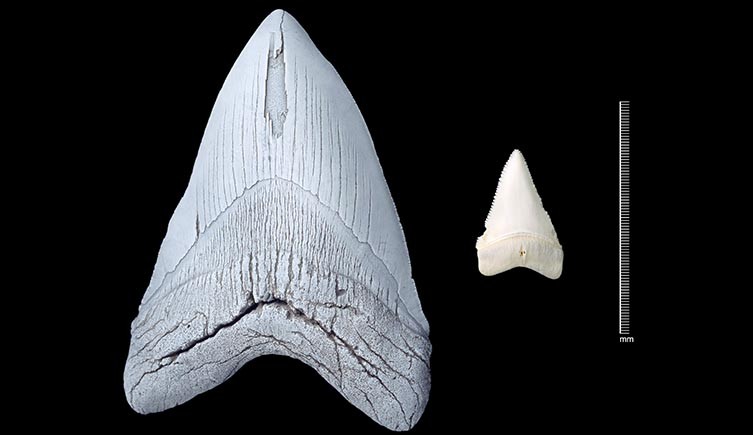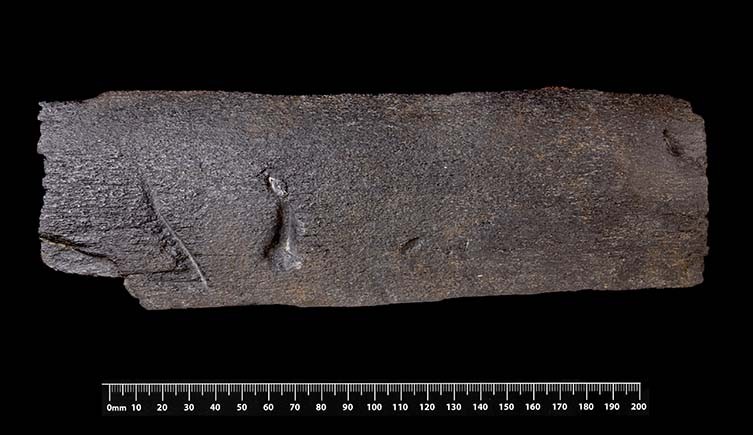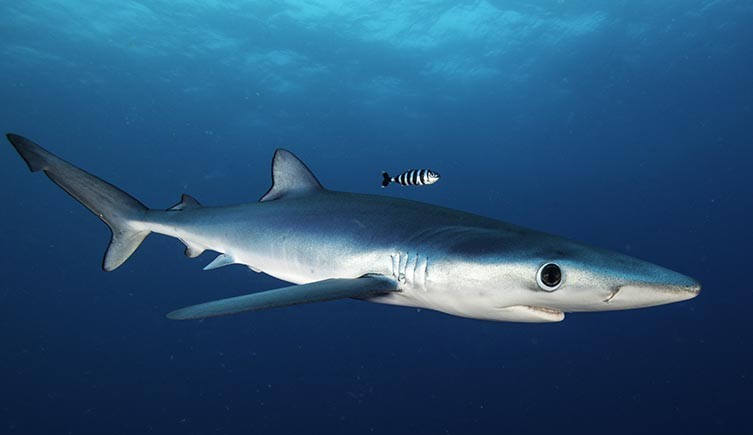Megalodon versus great white shark: understanding the size comparison between these ocean predators reveals fascinating insights into their dominance. At COMPARE.EDU.VN, we provide a comprehensive analysis, exploring the dimensions and characteristics that set them apart, offering a clearer picture of their place in marine history. Explore the history of the largest shark, compare sizes, weight, diet, habitat to gain a deeper knowledge.
1. Introduction: Unveiling the Giants of the Ocean
The ocean’s depths have always been home to magnificent creatures, and among them, two sharks stand out for their imposing presence: the megalodon and the great white shark. While the great white shark is a formidable predator known today, the megalodon, an extinct species, dwarfs it in comparison. This article aims to explore the colossal size difference between these two marine giants, providing a detailed comparison that sheds light on their unique characteristics and place in the history of the ocean. Discover what made megalodon so big with information from COMPARE.EDU.VN.
2. Megalodon: The Prehistoric Colossus
2.1. Definition and Origins
Otodus megalodon, often simply called megalodon, was the largest shark that ever lived, reigning over the oceans for approximately 20 million years until its extinction around 3.6 million years ago. The name “megalodon” means “large tooth,” a fitting moniker considering the enormous size of its teeth, which are the most common fossils found.
2.2. Estimated Size and Weight
Estimating the exact size of megalodon has been a challenge for paleontologists since complete skeletons are rare. Most estimates are based on the size of its teeth, which can reach up to 18 centimeters (7.1 inches) in length. Based on these measurements, scientists initially estimated that megalodon could reach lengths of 15 to 18 meters (49 to 59 feet).
Recent research, however, suggests that megalodon may have been even larger. By studying partial vertebral columns, scientists have proposed that O. megalodon could reach a staggering 24.3 meters (almost 80 feet) long. This would make it one of the largest marine predators ever to exist.
In terms of weight, it’s estimated that a megalodon could weigh between 50 to 100 tons, depending on its length.
2.3. Key Physical Characteristics
Apart from its massive size, megalodon possessed other distinctive features. Its jaws were estimated to be around 2.7 by 3.4 meters wide, large enough to swallow two adult humans side by side. The jaws were lined with 276 teeth, each designed for tearing through the flesh of large prey.
Based on fossil evidence, scientists believe that megalodon had a shorter, flatter snout compared to the great white shark. It also had extra-long pectoral fins to support its massive weight and size.
3. Great White Shark: The Modern Predator
3.1. Definition and Habitat
The great white shark (Carcharodon carcharias) is one of the most well-known and feared predators in the ocean today. Found in temperate waters around the world, great white sharks are apex predators, meaning they sit at the top of the food chain.
3.2. Average Size and Weight
Great white sharks are significantly smaller than megalodon. The average adult great white shark measures between 4.6 to 6 meters (15 to 20 feet) in length, with the largest recorded individuals reaching up to 6.4 meters (21 feet).
In terms of weight, great white sharks typically weigh between 680 to 2,268 kilograms (1,500 to 5,000 pounds).
3.3. Key Physical Characteristics
Great white sharks are characterized by their robust bodies, pointed snouts, and powerful jaws. Their teeth are serrated and triangular, perfectly adapted for seizing and tearing flesh. They possess a counter-shaded coloration, with a dark gray or bluish-gray dorsal side and a white ventral side, providing camouflage in the water.
4. Size Comparison: Megalodon vs. Great White Shark
4.1. Length Comparison
The most striking difference between megalodon and the great white shark is their size. Megalodon was significantly larger, with recent estimates suggesting it could reach lengths of up to 24.3 meters (almost 80 feet). In contrast, the largest recorded great white shark measured about 6.4 meters (21 feet). This means megalodon could have been almost four times the length of the largest great white shark.
4.2. Weight Comparison
The weight difference is equally staggering. Megalodon is estimated to have weighed between 50 to 100 tons, while great white sharks typically weigh between 680 to 2,268 kilograms (1,500 to 5,000 pounds). This means a megalodon could have weighed 20 to 40 times more than a great white shark.
4.3. Jaw and Bite Force Comparison
Megalodon’s jaws were enormous, estimated to be around 2.7 by 3.4 meters wide. This is easily big enough to swallow two adult people side by side. Great white sharks, while possessing powerful jaws, have a much smaller bite radius.
The bite force of megalodon was also significantly greater. Researchers estimate that megalodon had a bite force of between 108,514 and 182,201 Newtons (N). In comparison, great white sharks have a bite force of around 18,216N. This makes megalodon one of the most powerful predators to have ever existed.
5. Habitat and Distribution
5.1. Megalodon’s Range
Megalodon was adapted to warm tropical and subtropical locations around the globe. Fossilized megalodon teeth have been found on every continent except Antarctica. This wide distribution indicates that megalodon was a highly adaptable species, capable of thriving in a variety of marine environments.
5.2. Great White Shark’s Range
Great white sharks are found in temperate waters around the world, including the coasts of North America, South Africa, Australia, and Japan. They prefer cooler waters but can also be found in warmer regions.
5.3. Overlapping Habitats and Potential Interactions
There is evidence to suggest that the ranges of megalodon and great white sharks overlapped. Fossil records indicate that both species lived in similar regions during certain periods. Some scientists believe that competition with great white sharks for food may have contributed to megalodon’s extinction.
6. Diet and Hunting Strategies
6.1. Megalodon’s Prey
With its massive size and powerful bite, megalodon was capable of taking down large prey. Fossil evidence suggests that megalodon primarily fed on whales, large fish, and other sharks. Fossilized whale bones have been found with cut marks from megalodon teeth, providing direct evidence of its feeding habits. Megalodon would have hunted whales, dolphins, and even giant sea turtles.
6.2. Great White Shark’s Prey
Great white sharks are also apex predators, but their diet is more varied than that of megalodon. They feed on a variety of marine animals, including fish, seals, sea lions, dolphins, and seabirds. Great white sharks are known for their ambush hunting techniques, often attacking prey from below.
6.3. Comparative Analysis of Feeding Habits
While both megalodon and great white sharks are apex predators, their feeding habits differ significantly due to their size and capabilities. Megalodon was capable of taking down much larger prey than great white sharks, allowing it to dominate the marine food chain. The great white shark’s more varied diet allows it to adapt to different environments and prey availability, contributing to its survival in the modern ocean.
7. Evolutionary History and Lineage
7.1. Megalodon’s Ancestry
The earliest megalodon fossils date back to 20 million years ago. Megalodon’s evolutionary history is thought to stretch back to Cretalamna appendiculata, dating to 105 million years ago, making the lineage of megalodon over 100 million years old. The oldest definitive ancestor of megalodon is a 55-million-year-old shark known as Otodus obliquus, which grew to around 10 meters in length.
7.2. Great White Shark’s Ancestry
The great white shark’s evolutionary history is more recent. The ancestor to the great white shark lived alongside megalodon. Some scientists think they might even have been in competition with each other.
7.3. Divergence and Adaptation
The divergence of megalodon and the great white shark highlights the different evolutionary paths these sharks took. Megalodon evolved to become the largest shark ever, specializing in hunting large marine mammals. Great white sharks, on the other hand, adapted to a more varied diet and hunting strategy, allowing them to survive in a changing ocean environment.
8. Extinction of Megalodon: Why Did It Disappear?
8.1. Climate Change
Megalodon became extinct by the end of the Pliocene (2.6 million years ago), when the planet entered a phase of global cooling. The drop in ocean temperatures likely resulted in a significant loss of habitat for the warm-water adapted megalodon. It may also have resulted in the megalodon’s prey either going extinct or adapting to the cooler waters and moving to where the sharks could not follow.
8.2. Competition with Other Predators
Competition with great white sharks for food may also have contributed to megalodon’s downfall. Studies of fossilized megalodon and great white teeth show that their diets overlapped. As the ocean environment changed, great white sharks may have been better equipped to adapt and compete for resources.
8.3. Loss of Nursery Habitats
Megalodon is thought to have given birth to its young close to the shore. As ice formed at the poles and the sea level dropped, these pupping grounds would have been destroyed, reducing the survival rate of megalodon pups.
9. Misconceptions and Myths
9.1. Megalodon Still Alive?
Despite popular belief and sensationalized media portrayals, there is no credible evidence to suggest that megalodon is still alive today. If an animal as big as megalodon still lived in the oceans, we would know about it.
9.2. Exaggerated Size Claims
Some reports and fictional depictions exaggerate the size of megalodon. While it was undoubtedly a massive shark, scientific evidence suggests that it reached a maximum length of around 24.3 meters (almost 80 feet), not the much larger sizes sometimes claimed in popular culture.
10. Modern Research and Discoveries
10.1. New Fossil Finds
Ongoing research and new fossil finds continue to enhance our understanding of megalodon. Discoveries of partial skeletons and more complete teeth provide valuable insights into its size, anatomy, and behavior.
10.2. Technological Advancements in Size Estimation
Technological advancements, such as 3D modeling and computer simulations, are helping scientists to refine size estimations and create more accurate reconstructions of megalodon.
10.3. Genetic Studies and Evolutionary Relationships
Genetic studies, while limited due to the lack of preserved DNA, are helping to clarify the evolutionary relationships between megalodon and other shark species.
11. Table Summary: Megalodon vs. Great White Shark
| Feature | Megalodon (Otodus megalodon) | Great White Shark (Carcharodon carcharias) |
|---|---|---|
| Size | Up to 24.3 meters (80 feet) | 4.6 to 6 meters (15 to 20 feet) |
| Weight | 50 to 100 tons | 680 to 2,268 kilograms (1,500 to 5,000 pounds) |
| Bite Force | 108,514 to 182,201 N | 18,216 N |
| Habitat | Warm tropical and subtropical waters | Temperate waters worldwide |
| Diet | Whales, large fish, other sharks | Fish, seals, sea lions, dolphins |
| Extinction | 2.6 million years ago | Present |
| Jaw Size | 2.7 x 3.4 meters | Smaller relative to body size |
| Tooth Size | Up to 18 cm (7.1 inches) | Up to 7.6 cm (3 inches) |



12. Visual Comparison
13. Conclusion: A Tale of Two Sharks
The comparison between megalodon and the great white shark reveals the incredible diversity and power of marine predators. While the great white shark is a formidable predator in its own right, megalodon was a true giant, dominating the oceans for millions of years. Understanding the size, diet, and evolutionary history of these two sharks provides valuable insights into the dynamics of marine ecosystems and the factors that influence the survival and extinction of species.
14. FAQs: Understanding More About Megalodon and Great White Sharks
14.1. How big was the largest megalodon ever found?
The largest megalodon is estimated to have reached a length of up to 24.3 meters (almost 80 feet).
14.2. Could a megalodon eat a great white shark?
Given its size and bite force, it is plausible that a megalodon could have preyed on great white sharks, although direct evidence is lacking.
14.3. Why did megalodon go extinct?
Megalodon likely went extinct due to a combination of factors, including climate change, competition with other predators, and loss of nursery habitats.
14.4. Are megalodon teeth still being found today?
Yes, fossilized megalodon teeth are still being found today in various locations around the world.
14.5. Is there any chance megalodon could still be alive?
There is no credible evidence to suggest that megalodon is still alive today.
14.6. How does the bite force of megalodon compare to other animals?
Megalodon had one of the most powerful bite forces of any known animal, estimated to be between 108,514 and 182,201 Newtons (N).
14.7. What did megalodon eat?
Megalodon primarily fed on whales, large fish, and other sharks.
14.8. Where have megalodon fossils been found?
Megalodon fossils have been found on every continent except Antarctica.
14.9. How long did megalodon live?
Megalodon existed for approximately 20 million years, from the early Miocene to the end of the Pliocene.
14.10. What is the scientific name for megalodon?
The scientific name for megalodon is Otodus megalodon.
15. Call to Action
Interested in comparing more ocean giants or other fascinating creatures? Visit COMPARE.EDU.VN today to explore detailed comparisons, insightful analyses, and expert opinions that will help you make informed decisions and expand your knowledge. At COMPARE.EDU.VN, we strive to provide objective and comprehensive comparisons to help you make informed decisions.
Need more information or have questions? Contact us at:
Address: 333 Comparison Plaza, Choice City, CA 90210, United States
Whatsapp: +1 (626) 555-9090
Website: compare.edu.vn